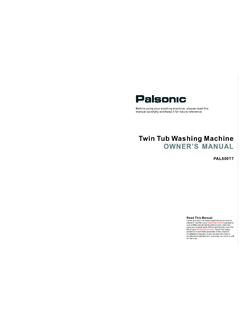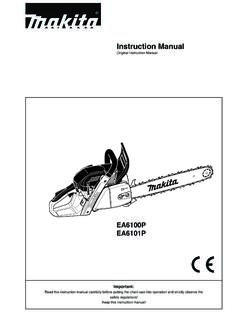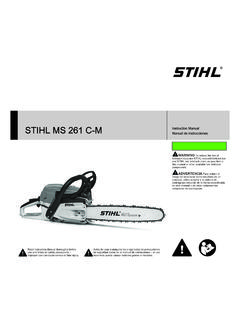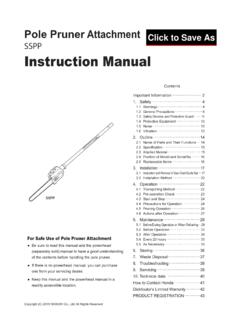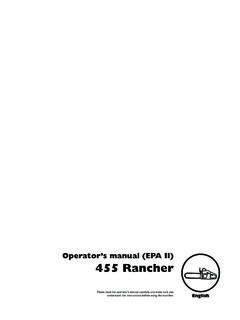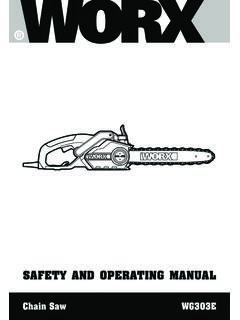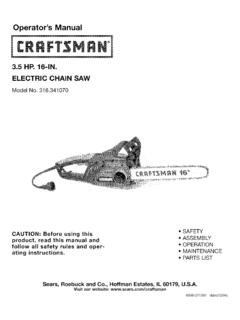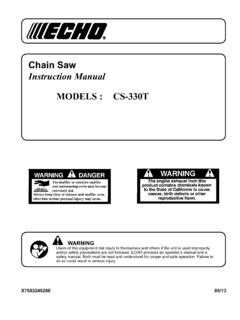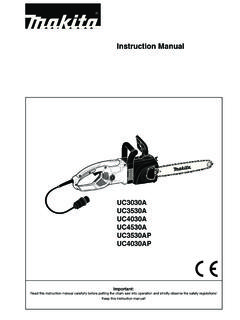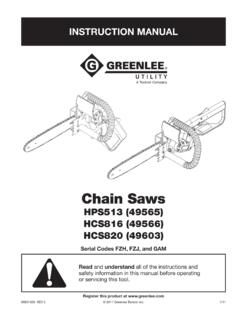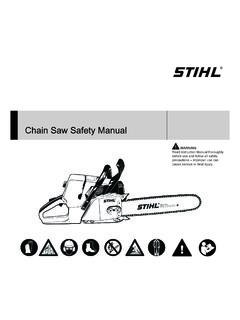Transcription of INSTRUCTION MANUAL - ProductReview.com.au
1 ELECTRIC CHAINSAW1800 WINSTRUCTION MANUALSPECIFICATIONSP ower: 1800 WBar Length: 355mm (14 ) chain Speed: Type: OregonChain Pitch: (3/8 )Sharpening File: 5/32 Oil Feed: Automatic Oil Tank Capacity: 125mlChain Oil: Standard chain Bar OilWeight: S IN THE BOXE lectric ChainsawSpanner/ chain Tension AdjusterGuide Bar Cover MANUALScan this QR Code with your mobile device to take you to the online YOUR PRODUCTSETUP & PREPARATION1 Rear handle2 Cord retainer3 On/off switch4 chain oil filler cap5 Front handle6 Hand guard/ chain brake7 Chain8 Guide bar9 Oil level window10 Side panel11 Bar securing nut12 Bucking spikes13 Bar securing nut cover (fitted)14 Spanner/ chain tension adjustor1. chain & BARELECTRIC CHAINSAWACCESSORIES1910111213234678145 IMPORTANT: IT IS VITAL FOR THE PROPER AND SAFE OPERATION OF THE CHAINSAW THAT THE chain IS TENSIONED a chain and bar1.
2 Remove the bar securing nut cover using the flat end of the tool. 2. Remove the bar securing nut then the side panel. 3. Fit the chain over the guide bar making sure that the cutters are facing in the direction of Place the guide bar and chain in position ensuring the chain is around sprocket wheel (B).Note: If required adjust chain tension screw to move the tension lug back to allow the bar to fitBBefore assembling or disassembling a chain be sure to disconnect the chainsaw from the power wear gloves when handling the chain as it is very sharp and can cut you when it is not : ONLY USE OIL THAT IS EXPRESSLY LABELLED chain BAR OIL .2. chain BAR OIL1. Remove the chain bar oil cap and fill the tank. chain Bar Oil Tank Capacity: 125ml2. Refit cap and clean any oil Always fill the oil tank when the oil level is below the minimum mark on the oil level To check the lubricating system, switch on the chainsaw and hold it with the guide bar and chain above some light coloured paper such as newspaper.
3 A steadily increasing stain caused by oil spray shows the lubricating system is !: NEVER START WORK UNLESS THE chain AND BAR ARE : THE chain SHOULD BE ADJUSTED BEFORE FIRST USE, AGAIN AFTER 2-3 MINUTES OPERATION AND RECHECKED AND ADJUSTED IF NECESSARY AFTER EACH FURTHER 30 MINUTES OF USE. TAKE CARE NOT TO OVER TENSION THE Adjust the chain tensioning screw (C) until the bolt (A) fits into the hole in the guide Fit the side panel back onto the chainsaw and replace the bar securing nut finger tight only. 7. Adjust the tension on the chain using the chain tension screw (C). The tension is correct when the chain can be pulled 3mm away from the guide bar when using your finger and not over-tighten as this will reduce the life of the chain and guide Tighten the bar securing Replace the bar securing nut gap is the ideal tensionNOTE: chain BAR OIL MAY LEAK IF THE TOOL IS LEFT FOR LONG PERIODS.
4 THIS IS NORMAL. IF THE TOOL IS TO BE LEFT UNUSED FOR AN EXTENDED TIME, DRAIN THE OIL FROM THE TOOL. REFILL BEFORE CORD RETAINER4. chain BRAKEOPERATION1. Make a loop in the end of the extension lead and pass the loop though the hole in the handle and hook the loop over the cord Connect the extension lead to the power Pull the extension cord to secure it in position over the cord retainer. Route the power and extension cord away from the work area to prevent contact with the brakeThe chain brake operates automatically in the event of kick back. The chainsaw is fitted with a hand guard/ chain brake which when operated brings the chain to a stop within a tenth of a second. The cord retainer is used to anchor an extension cord when it is connected to the power lead of the tool.
5 It prevents the extension cord from being accidentally disconnected from the tool power cable or shaken loose during chain brake can be operated manually by pushing it forward or automatically as a result of kickback. Kick back occurs if the chain catches on the wood being cut and the chainsaw pushes back the event of kick back, your hand (which is on the front handle during operation) jerks forward causing the back on your hand to push the guard forward, engaging the chain brake and quickly stopping the ONBRAKE OFFNote: Always use an approved extension lead suitable for power input of this SWITCHING ON/OFF6. CUTTING1. Press the bucking spikes against the timber ensuring the chain is not making contact with the material being Start cutting by holding the chainsaw by the front handle and raising the rear handle.
6 3. If you cannot cut the timber in a single stroke, apply light pressure to the front handle and continue sawing, draw the chainsaw back a little then apply the bucking spikes a little lower and finish the cut by raising the rear Withdraw the chainsaw from the cut while the chain is still onSwitching off1. Pull the hand guard/ chain brake towards you. The brake may be stiff and may require to be moved with some force. If the brake is engaged the chain will not Release the on/off switch. The chain quickly stops but the motor will take a short time to continue to run Hold the front handle with your left hand and the rear handle with your right Use the thumb of your right hand to push the lock-off switch in and squeeze the on/off switch to start the motor. 4. The chain will now be running, ready to make a cut.
7 Release the lock-off in the chainPrior to operation, a new chain should be run in for 2 3 minutesand then its tension should be checked and adjusted asdetailed in MAINTENANCE .CAUTION: FIRST TIME USERS SHOULD, AS A MINIMUM PRACTISE, CUT LOGS ON A SAW-HORSE OR CRADLECAUTION: POSITION THE CORD SO THAT IT WILL NOT BE CAUGHT IN BRANCHES DURING CUTTINGCAUTION!: AVOID CUTTING INTO THE GROUND AS THIS WILL VERY QUICKLY DULL THE SAW is cutting a log into lengths for easier handling. To saw a log lying on the ground, first saw halfway, then roll the log over and cut from the opposite saw the end of a log supported off the ground, first saw up from the bottom one-third through the log then finish by sawing down from the top. To saw a log in the middle of two supports holding it off the ground, first saw down from the top one-third through the log then finish by sawing up from the is the process of removing the branches from a fallen tree.
8 Check the direction in which a branch will bend before cutting it. Always cut on the opposite side to the bending direction so that the guide bar is not pinched in the cut. For large limbs that cannot be removed in one cut, make an initial cut from the bent side and finish by sawing from the opposite direction. Do not remove limbs that are supporting the fallen tree on the ground until the tree has been cut into the chain tension Maintaining the guide barPruning is the removal of a limb or branch from a standing a treeDecide the direction in which you wish the tree to fall taking into account the direction of the wind, the position of branches, lean of the tree, ease of subsequent limbing and bucking and other factors prevalent at the Remove the bar securing nut cover using the flat end of the spanner/ chain tension Remove any sawdust from the groove in the guide bar, including the groove.
9 Oil and sawdust combine and emit a burning smell during operation if the blade is not regularly Make sure that the oil port is not clogged. Grease the nose sprocket at the tip of the guide Check for oil leakage and loose fastenings, especially those securing the handles and the guide Cleaning around sprocket and chain , oil feed Clean any dust away from the cooling vents as clogged vents can cause overheating. By maintaining a clean unit you will extend the useful life of the chain and the tool in Using the spanner, loosen the bar securing nut so that it is finger tight Adjust the tension on the chain using the chain tension screw (C). The tension is correct when the chain can be pulled 3mm away from the guide bar when using your finger and thumb. Do not over-tighten as this will reduce the life of the chain and guide Tighten the bar securing nut.
10 5. Replace the bar securing nut !: FELLING A TREE SHOULD ONLY BE DONE BY TRAINED !: ALWAYS KEEP A BALANCED STANCE. DO NOT STAND ON THE LOG. BE ALERT TO THE FACT THAT THE LOG MAY ROLL OVER. WHEN WORKING ON A SLOPE, ALWAYS STAND ON THE UP HILL SIDE OF THE !: AVOID CUTTING INTO THE GROUND AS THIS WILL VERY QUICKLY DULL THE SAW !: DO NOT USE AN UNSTABLE FOOTHOLD OR LADDER. DO NOT OVERREACH. DO NOT SAW ABOVE SHOULDER HEIGHT. ALWAYS USE BOTH HANDS TO HOLD THE SAW. FIRST CUT UP FROM THE BOTTOM AND FINISH DOWN FROM THE T O : BEFORE CLEANING YOUR CHAINSAW OR CARRYING OUT ANY MAINTENANCE PROCEDURE, MAKE SURE THAT THE MOTOR IS OFF AND THE TOOL DISCONNECTED FROM THE POWER SUPPLY TO PREVENT ACCIDENTAL : THE chain HAS SHARP EDGES. FOR YOUR SAFETY PLEASE USE WORK gap is the ideal tensionCHINTS & TIPS Do not force the saw into the cut.



